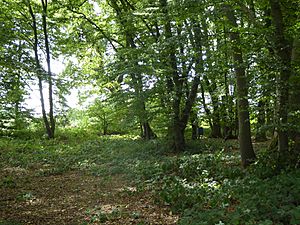Shotesham-Woodton Hornbeam Woods facts for kids
| Site of Special Scientific Interest | |

Shotesham Little Wood
|
|
| Area of Search | Norfolk |
|---|---|
| Interest | Biological |
| Area | 40.4 hectares (100 acres) |
| Notification | 1988 |
| Location map | Magic Map |
Shotesham-Woodton Hornbeam Woods is a very special natural area in Norfolk, England. It covers about 40.4 hectares, which is like 100 football fields! This place is so important for nature that it's called a Site of Special Scientific Interest (SSSI). This means it's protected by law because of its unique plants and trees.
Contents
What Makes These Woods Special?
Shotesham-Woodton Hornbeam Woods is actually made up of four different ancient woodlands. These are Shotesham Little Wood, Saxlingham Grove, Hempnall Little Wood, and Winter’s Grove. They are all found east of Newton Flotman in Norfolk.
Ancient Trees and How They Grow
These woods are home to many old hornbeam trees. These trees have been growing here for a very long time. The woods use a special way of managing trees called "coppice with standards."
Understanding Coppice with Standards
- Coppicing: This is when trees are cut down close to the ground. This makes them grow many new shoots from the stump. It helps the trees stay healthy and provides wood.
- Standards: These are a few taller trees that are left to grow big and strong. They provide shade and homes for animals. This method helps keep the forest diverse and full of life.
The Ground Beneath Your Feet
The soil in these woods is made of something called "boulder clay." This type of clay was left behind by glaciers many thousands of years ago. It's very rich and helps many different plants grow well.
Amazing Plants You Might Find
The ground in these woods is full of interesting and rare plants. It's like a hidden garden for special species.
Rare Flowers and Their Beauty
Some of the plants found here are not common at all. They need specific conditions to grow, which these woods provide.
- Herb paris: This plant has a very unique look with four leaves in a cross shape and a single green flower.
- Stinking iris: Despite its name, which comes from the smell of its crushed leaves, this plant has beautiful purple or yellow flowers. It also produces bright orange seeds in autumn.
- Greater butterfly orchid: This is a stunning wild orchid with delicate white flowers that look a bit like butterflies. It's a joy to see!
Protecting These Special Woods
Because these woods are so important for nature, they are private land. This means there is no public access to them. This helps protect the delicate plants and animals that live there from being disturbed. By keeping them undisturbed, these woods can continue to thrive and be a home for rare species for many years to come.

